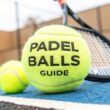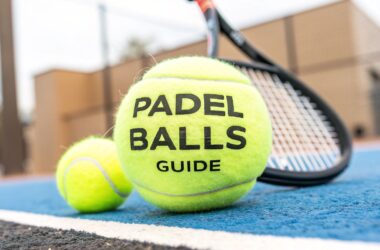So you're ready to jump into the exciting world of padel? It’s an incredible sport, mixing the high-energy feel of tennis with the strategic wall play of squash. Whether you're a seasoned tennis player or totally new to racquet sports, getting a handle on the basic rules is your first step to having a blast on the court.
Right off the bat, you should know that padel is almost always played as a doubles match. This makes it a super social and team-focused game from the get-go.
Understanding the Core Principles of Padel
The whole game is designed to create longer, more exciting rallies. The rules are built for fast-paced, fun gameplay on a court that's smaller than a tennis court, measuring 20m by 10m. It's enclosed by glass or solid walls, which is where things get really interesting.
The scoring is easy to pick up if you know tennis—it uses the same 15, 30, 40 system, and matches are usually the best of three sets. What really makes padel unique is this combination of a smaller court and the surrounding walls. As you'll see, it completely changes the game.
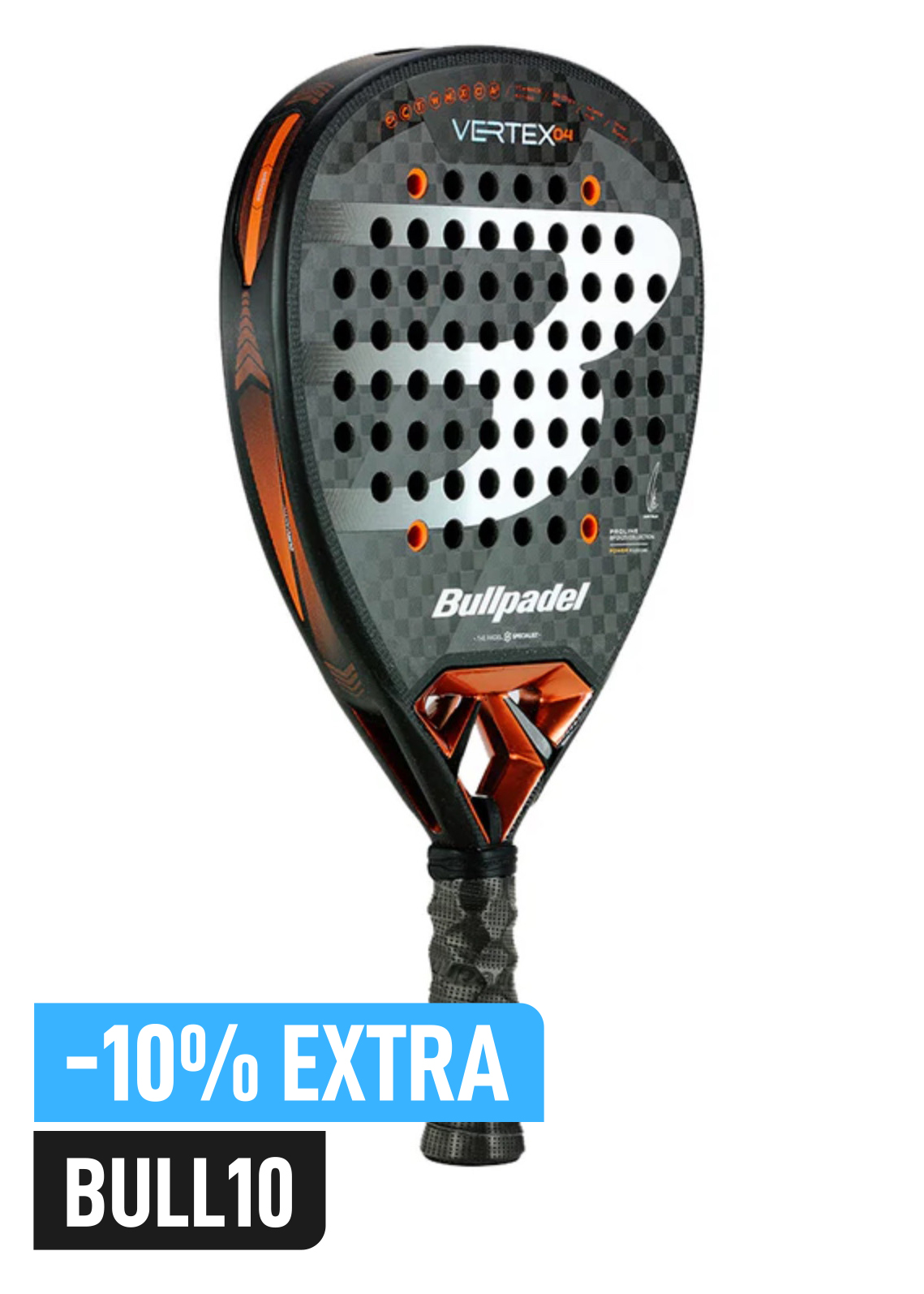
Buy the best padel gear to level up your next game!
CHECK OUT this deal from Padel Market!Get ready to take your game to the next level with the latest padel gear from Padel Market! Fast EU and Worldwide Shipping
For a deeper dive into the sport's incredible growth and court details, check out these padel statistics.
Padel vs Tennis: A Quick Comparison
To really get it, it helps to see how padel stands apart from traditional tennis. The goal is the same: hit the ball over the net so your opponents can't legally return it. But how you do that is completely different.
The biggest game-changers are the serve, the court itself, and the paddle. Getting these differences down is key for new players to shake off any old tennis habits and start playing smart from day one.
The real beauty of padel is how easy it is to pick up. The underhand serve is way less intimidating than a big tennis serve, and the walls keep the ball in play longer. This means even total beginners can have fun, competitive rallies right away.
This image gives you a great visual of how the court, equipment, and scoring all tie together.
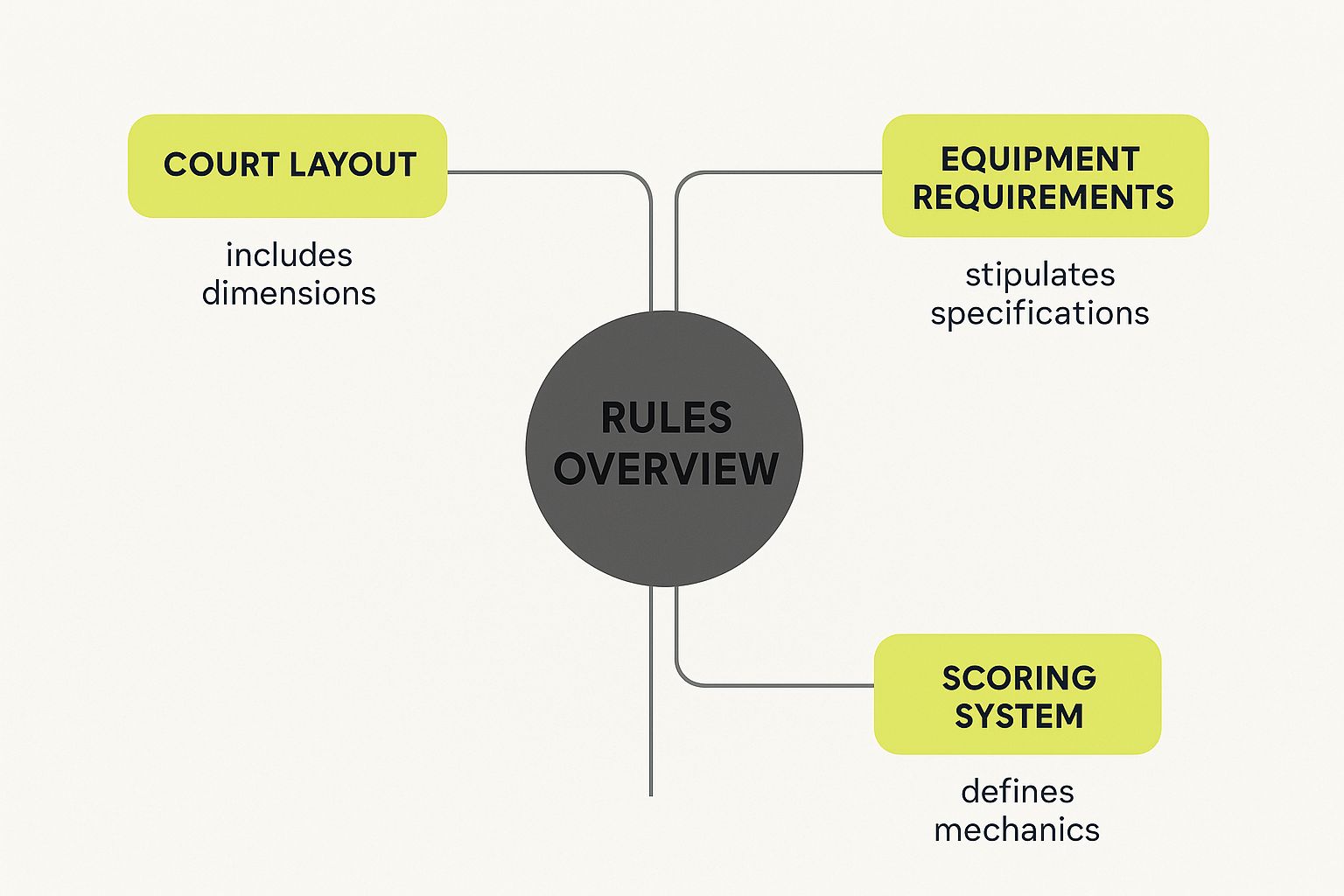
As you can see, these three pillars—the court, the gear, and the scoring—are what give the game its unique structure and feel.
Key Rule Differences Between Padel and Tennis
For anyone coming from a tennis background (or just trying to explain the game to a friend), it's helpful to see the main differences laid out side-by-side. This quick comparison table breaks down the essentials that set these two great sports apart.
| Feature | Paddle Tennis Rule | Traditional Tennis Rule |
|---|---|---|
| Court Size | Smaller (20m x 10m) and enclosed by walls. | Larger (23.77m x 10.97m) and open. |
| The Serve | Must be underhand, with contact at or below the waist. | Can be overhand or underhand. |
| Wall Play | Walls are in! You can play the ball off them after it bounces. | Walls are out of bounds; the point is over if the ball hits anything. |
| Racket | Solid, stringless paddle with holes. | Larger racket with strings. |
| Ball | Slightly lower pressure for less bounce and more control. | Standard tennis ball with higher pressure. |
These aren't just minor tweaks; they fundamentally change the strategy, the technique, and the whole vibe of the game. Now that you've got the big picture, we can start digging into the details of the court and equipment.
Understanding the Court and Your Equipment
Before you can truly get a feel for the rules, you need to get familiar with your playground and your tools. The padel court isn’t just a patch of turf; it’s an active part of every single point, and the gear is designed specifically for this unique game. Don't think of it as a flat playing field—picture it more like a three-dimensional arena where the walls are your allies.
The official court dimensions are always the same: a perfect rectangle 20 meters long and 10 meters wide, completely enclosed by walls. This consistency is key for fair play across the board. While padel courts are standardized, it’s interesting to see the nuances of understanding varied field sizes in other sports to appreciate why this matters.
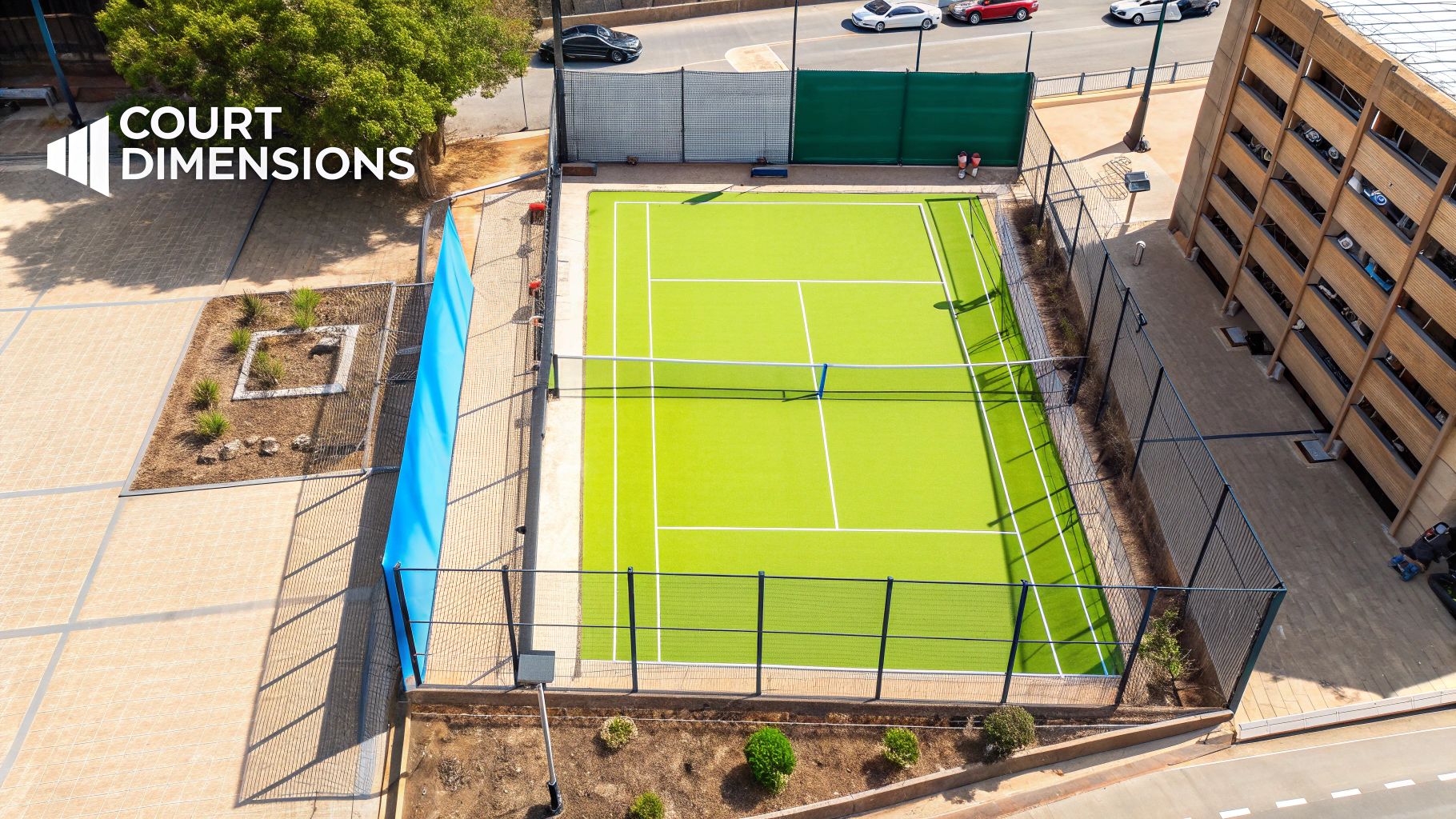
Anatomy of the Padel Court
What truly sets a padel court apart are its walls, which are usually glass at the back and a mix of glass and wire mesh along the sides. These aren't just boundaries—they're a fundamental part of the game.
Once the ball bounces on your side of the court, you can legally play it off any of the glass walls. This single rule is what creates those wild, ricocheting rallies that make padel so addictive. The wire mesh fence plays by a different rule, though: if the ball smacks into the mesh before bouncing on the ground, that's a fault.
Here are the key zones you need to know:
- Service Lines: These run parallel to the net, 6.95 meters back, marking the depth of the service boxes.
- Service Boxes: This is your target for the serve. You’ll notice there’s no center "T" line that goes all the way to the back like in tennis.
- Net: The net stands 88 cm high at its center. It’s a bit lower than a tennis net, which really opens up the court for aggressive net play and quick-fire volleys.
Your Essential Padel Gear
Picking the right equipment isn't just about personal preference; specific rules govern your gear to keep the game fair and fun. What you bring to the court has a huge impact on your control, power, and safety.

Buy the best padel gear to level up your next game!
CHECK OUT this deal from Padel Market!Get ready to take your game to the next level with the latest padel gear from Padel Market! Fast EU and Worldwide Shipping
The star of the show is, of course, the padel racket, or pala. It’s a solid, stringless paddle covered in holes. This design isn’t for looks; the solid foam core gives you power, while the holes cut down on air resistance so you can swing faster. The absence of strings provides a totally different feel and level of control compared to any other racket sport.
The big takeaway here is that padel gear is engineered for control and longer points. The solid paddle and lower-pressure ball are designed to work together, slowing the game just enough to make strategy more important than pure power.
The Padel Ball Explained
At first glance, a padel ball looks just like a tennis ball, but they're definitely not interchangeable. Official padel regulations state that the padel ball must have lower internal pressure. This small difference makes a massive difference in how the game is played.
A lower-pressure ball bounces less than a tennis ball. This leads to more controlled shots and stops the ball from rocketing off the glass walls, which is exactly what encourages those longer, more tactical rallies.
Finally, don't overlook your shoes. Padel is played on artificial turf, so you’ll want shoes with a herringbone or clay court sole. This type of sole gives you the grip you need for sharp side-to-side movements without getting stuck on the surface. The right shoes reduce your risk of injury and let you move around the court with confidence. Show up with the right gear, and you're ready to play safely and effectively.
Mastering the Underhand Serve
Every single point in padel kicks off with a serve. But if you're coming over from tennis, prepare for a totally different ball game. Forget the powerful, overhead slams you're used to. The padel serve is a gentle, strategic shot hit underhand.
This rule is a game-changer. It’s what makes padel so incredibly easy to pick up and a huge reason for its booming popularity. The simple underhand serve, paired with a familiar scoring system and an enclosed court, is the secret sauce to its rapid global takeover.
But don't mistake simplicity for a lack of strategy. The underhand serve is a core part of the game's DNA, designed to start a rally, not blast an ace past your opponent.
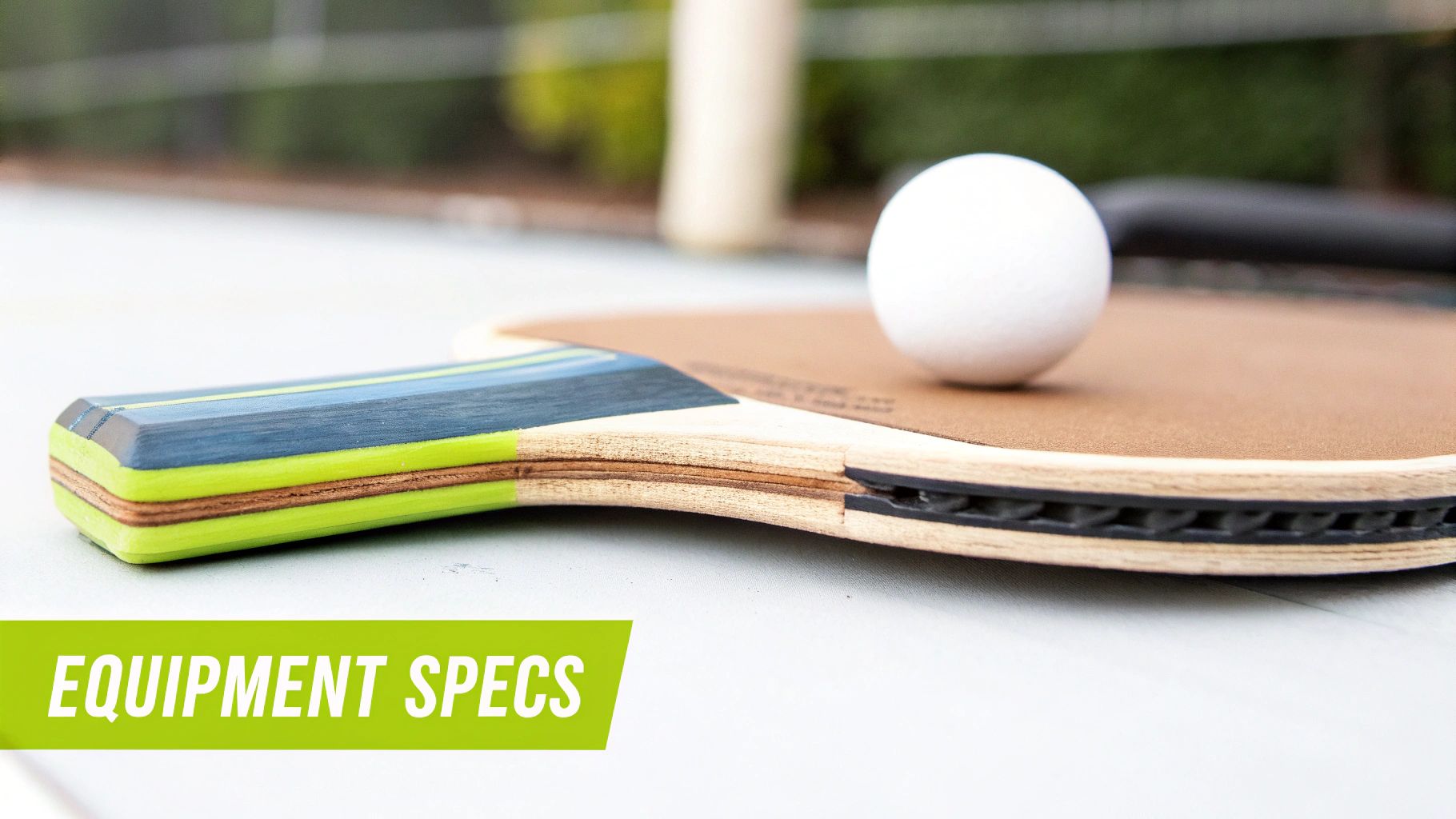
The Step-by-Step Serving Motion
Nailing a legal and effective serve boils down to a few key steps. Get this sequence down, and you’ll start every point with confidence, setting yourself up for success.
- Server Positioning: You need to stand behind the service line, somewhere between the center line and the side wall. At least one of your feet has to stay on the ground, and you can't touch or cross the service line until after you've hit the ball—that’s a foot fault.
- The Bounce: You must let the ball bounce once on the ground before you hit it. This bounce also has to happen behind the service line in the area where you're standing.
- Contact Point: This is the big one. Your contact with the ball must be at or below your waist. A good rule of thumb is to think of your belly button as the absolute highest point. Anything higher is a fault.
- The Target: Your serve has to fly diagonally over the net and land in your opponent's service box. For the serve to be "in," the ball has to bounce inside the lines of that box.
The whole point of the padel serve is control, not power. You aren't trying to hit an ace. Your real goal is to place the ball in a tricky spot that immediately puts your opponent on the back foot.
Understanding Service Faults
Knowing how to serve is only half the battle; you also need to know what a fault is. Getting a handle on these common slip-ups will stop you from giving away cheap points and ensure you’re playing by the book.
Every server gets two chances to make a legal serve. If you mess up the first one, you get a "second serve." Miss that one too, and you lose the point. Simple as that.
Here are the most common ways to fault:
- Foot Fault: Stepping on or crossing the service line before contact.
- High Contact: Hitting the ball above your waist.
- Missed Ball: Taking a full swing at the ball and missing it completely.
- Wrong Target: The ball lands anywhere outside the correct diagonal service box.
For a deeper dive, check out our guide on the intricacies of padel serve rules.
What Is a Let Serve?
Every now and then, a serve has to be replayed. This is called a "let." A let doesn't count as a fault; you just get to retake that specific serve, whether it was your first or second attempt.
A serve is called a let in a few situations:
- The ball clips the net and then lands in the correct service box.
- The ball hits the net, lands in the box, and then hits an opponent before it bounces a second time.
- You serve when the receiver isn't ready.
There's also a quirky padel rule about hitting the fence. If your serve lands in the right box and then hits the wire mesh fence on the side, it's a fault. But, if it hits the glass wall after bouncing in, the serve is good and the point continues. This is a crucial difference that catches a ton of new players off guard
How to Keep Score in Paddle Tennis
If you’ve ever watched a game of tennis, the scoring in padel will feel pretty intuitive right from the start. It uses that same quirky 15, 30, 40 point progression, but the glass walls and constant action add a unique flavor that makes every point feel electric.
Don't sweat it if you're new to this. We'll walk through it together, step-by-step.
Think of it like building blocks. You win individual points to win a game. You stack up games to win a set. Win two out of three sets, and you’ve won the match. Simple, right? The whole thing starts with winning that first point.
So, how do you win a point? Easy. You win when your opponents mess up their return. Most of the time, this means the ball bounces twice on their side of the court, they smack it into the net, or they hit it straight out of the court before it even has a chance to bounce.
From Points to Games
Once the points start rolling in, the score starts climbing. Let’s play out a quick game to see how it works. Imagine your team is serving, and the score is “love-all” (which is just a fancy way of saying 0-0).
- First Point: You win the first rally. Score is now 15-love.
- Second Point: You win again! Now it's 30-love.
- Third Point: Your opponents finally get one. The score is 30-15.
- Fourth Point: You take the next point. Score moves to 40-15.
At 40-15, you're on the verge of victory. This is called a "game point." All you need is one more point to close it out. If you win that next rally, you take the game, and the set score becomes 1-0 in your favor. Just remember, the server's score is always called out first.
Key Takeaway: The score always goes 15, then 30, then 40. Winning the fourth point clinches the game, as long as your opponent isn't also at 40. This setup makes every single point crucial, especially as the score gets tight.
The Drama of Deuce and Advantage
Okay, but what happens if both teams are deadlocked at 40-40? This is where the real fun begins. A tie at 40-40 is called "deuce."
To win from deuce, a team has to win two points in a row. No exceptions.
- If the serving team wins the first point after deuce, the score becomes "Advantage In" (or Ad-In for short).
- If the receiving team wins it, the score is "Advantage Out" (Ad-Out).
If the team with the "advantage" wins the very next point, they win the game. But if they lose it, the score snaps right back to deuce, and the tug-of-war starts all over again. This can lead to some of the most nail-biting, back-and-forth moments in a match.
Winning the Set and Match
Winning games is just the first step. To win a set, your team needs to win at least six games, and you have to win by a margin of at least two. So, a score of 6-4 is a winner, as is 7-5.
But what if the game score gets tied at 6-6? That’s when you play a tie-break to decide the set. In a standard tie-break, the first team to seven points (winning by two) takes it. The scoring is simple—1, 2, 3, etc.—but the serving rotation gets a little different, adding another layer of strategy. For a complete overview of how these elements come together, our detailed guide on the fundamental rules of padel can provide more context.
This scoring system is a huge reason the sport is exploding globally. In 2025, the growth was historic: international padel tournaments shot up from 71 events in early 2024 to 132 in the first half of 2025—that's an 86% increase. The pro circuits all use these standard rules, which help create the long, strategic rallies that fans can't get enough of.
Most of the time, a padel match is the best of three sets. The first team to lock down two sets takes home the victory, ending a battle of skill, teamwork, and pure grit.
Playing the Rally and Using the Walls
Once the serve is in, the real game begins. The rally is the heart and soul of padel—a fast-paced exchange where quick thinking, sharp reflexes, and the court's unique geometry all come into play. Forget what you know about tennis, where everything is confined between the lines. Padel throws in the walls, turning the court into a 360-degree arena.
The golden rule that dictates every single rally is the one-bounce rule. After the ball flies over the net, it must bounce once on your side of the court before it touches any of the surrounding glass or fence. That’s it. This one simple principle shapes the entire game. If the ball smacks a wall before that first bounce, the point goes to your opponent.
This rule forces you into a constant state of decision-making. Do you attack the ball early with a volley? Or do you hang back, let it bounce, and play it off the back glass? Getting a feel for this choice is what separates the beginners from the seasoned players.
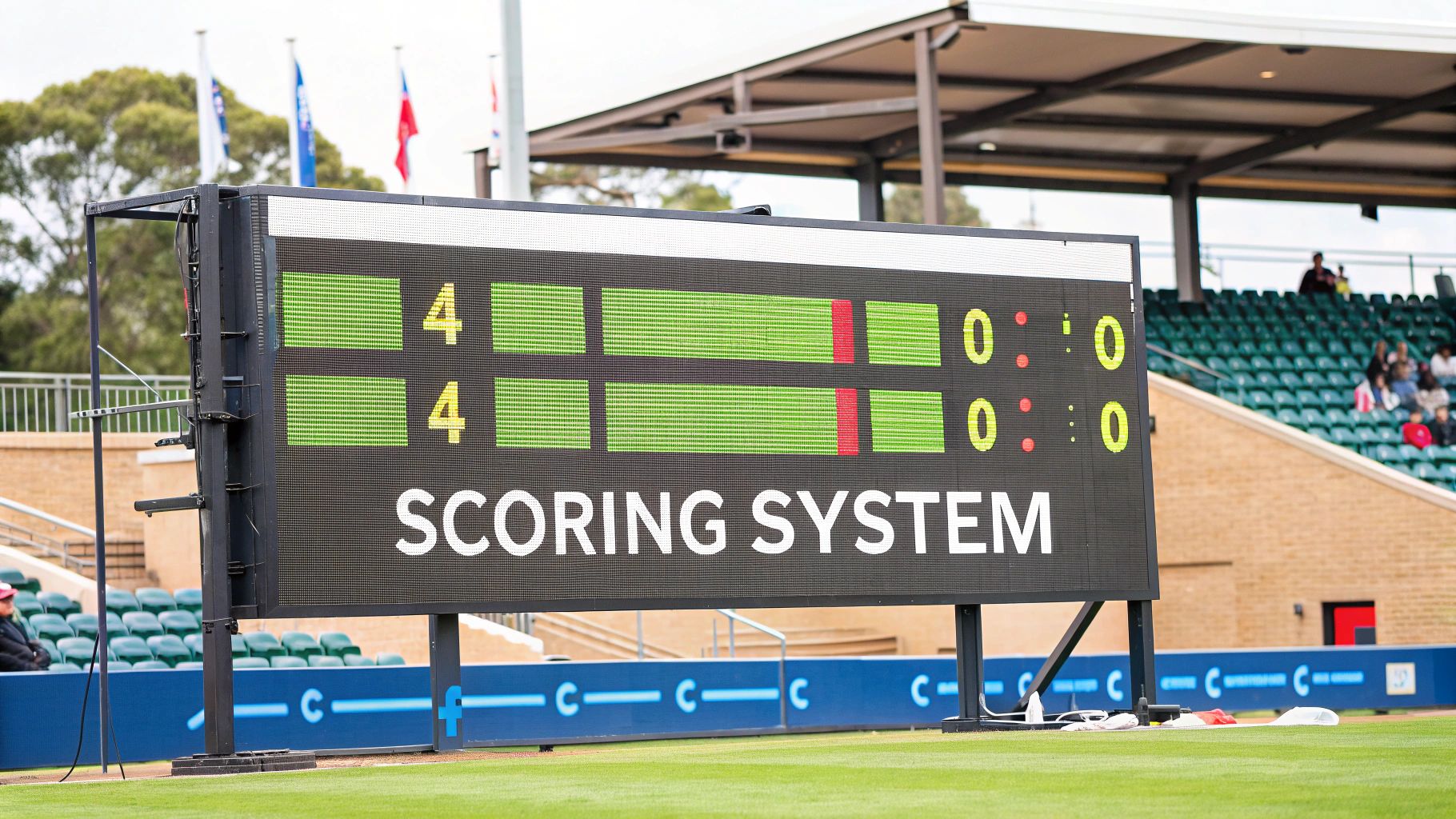
Turning Defense Into Offense with the Walls
Learning to use the walls isn't just a fancy trick; it's the core of padel strategy. Those glass walls aren't just boundaries—they're your best friends on the court. When your opponents blast a deep shot, the back glass is your lifeline, giving you the time and space needed to reset and hit a solid return.
Here’s how a legal, wall-assisted shot works:
- The ball comes over the net from your opponent.
- It bounces once on your side.
- The ball then rebounds off the back or side glass wall (or even both).
- You must strike the ball before it bounces a second time.
Mastering this sequence is a game-changer. It allows you to transform a desperate defensive scramble into a clever offensive play, often catching your opponents flat-footed as they charge the net. Using the side walls can also help you create wicked angles that are almost impossible for the other team to chase down.
The biggest mental hurdle for new padel players is learning to trust the back wall. Stop seeing it as an enemy. Let the ball come off the glass—it buys you precious seconds to get your feet set, prepare your shot, and take back control of the point. Rushing to hit every ball before it reaches the glass is a classic rookie mistake.
Common Faults That End a Rally
While padel encourages creativity, the rules about what ends a point are crystal clear. A rally is over the second a team commits a fault. Knowing these inside and out is crucial so you always know when you've won or lost a point.
You will lose the point immediately if:
- Double Bounce: The ball bounces more than once on your side of the court.
- Net Touch: A player or their racket makes contact with the net while the ball is in play.
- Hitting the Fence First: The ball hits the wire mesh fence before it bounces on the ground.
- Out of Bounds: The ball is hit directly out of the court without bouncing in first.
- Double Hit: You accidentally hit the ball twice in a single swing.
One of the most definitive faults is touching the net. Think of the net as a sacred, no-go zone. If your body, clothes, or racket touches it during a point, the rally is over instantly. No arguments, no do-overs.
To make it even clearer, here's a breakdown of some of the most common faults you'll see during a rally.
Common Faults During a Padel Rally
This table summarizes the key mistakes that will cost you the point during a back-and-forth exchange.
| Fault Type | Description | Result |
|---|---|---|
| Volley Fault | Hitting the ball on the fly before it has crossed over the net (i.e., reaching into your opponent's side). | Loss of Point |
| Wrong Side of Ball | The ball hits a player or their clothing, rather than their racket. | Loss of Point |
| Incorrect Wall Play | Returning the ball by hitting it off a wall on your own side before it has bounced on the ground. | Loss of Point |
| Second Bounce Return | Hitting the ball after it has already bounced twice on your side of the court. | Loss of Point |
Knowing these rules by heart builds confidence. It frees you up to play with more aggression and flair, letting you push the limits of what's possible on the court while staying squarely within the game's legal boundaries.
On-Court Etiquette and Unwritten Rules
Sure, you can learn all the shots and strategies, but what really makes you a great padel player is understanding the culture of the game. Beyond the official rulebook, padel is all about sportsmanship. These unwritten rules are what keep matches fun, fair, and flowing smoothly for everyone. Honestly, getting these right is just as crucial as perfecting your bandeja.
It all starts with good communication. Simple, clear calls are your best friend on the court. A quick "yours," "mine," or "wall" helps you and your partner move as one, preventing those awkward (and point-losing) moments of confusion. This constant chatter builds chemistry and makes you a formidable team.
Respect for Players and the Game
Here’s a simple one that makes a huge difference: always announce the score before you serve. A quick, clear call (always saying the server's score first) stops any arguments before they start and keeps the rhythm of the game going. It’s a tiny gesture of respect that goes a long way.
Sportsmanship really shows its colors when it comes to close line calls. The golden rule here is to give your opponents the benefit of the doubt. If you're even a little unsure if a ball was in or out, the point goes to them. End of story. Arguing over a millimeter of fuzz just kills the vibe and slows everything down.
Pro Tip: Don't forget to acknowledge a great shot, whether it comes from your partner or your opponents. A quick "nice shot!" or a paddle tap creates a fantastic atmosphere and shows you're there to appreciate good padel, no matter who's hitting the ball.
Another mark of a great court-mate is how you handle stray balls. If a ball from the next court rolls over, be a good neighbor and get it back to them safely and quickly. By the same token, be mindful of where your own balls end up and grab them between points so you don't interrupt another match.
Warming Up and Winding Down
Good etiquette isn't just for the match itself; it starts before the first point and ends after the last. Always take a few minutes to warm up with your opponents. This lets all four players get a feel for the court, the bounce, and each other's pace.
And when the final point is played, win or lose, you meet at the net. A handshake or a paddle tap is the traditional sign-off. It’s a simple reminder that while the competition can be intense, the respect for each other is what truly matters. Following these unwritten rules paddle tennis players live by will make you the kind of player everyone wants on their court.
Common Questions About Paddle Tennis Rules
Even after you've got the basics down, certain situations on the court can leave even seasoned players pausing. Padel has its own unique quirks, and a few common questions pop up time and time again during a match. This section is all about giving you quick, clear answers for those in-the-moment head-scratchers so you can settle the debate and get back to the game.
Let's dive into some of the most frequent queries that come up during serves and rallies.
Can I Volley the Return of a Serve?
Nope, never. This is one of padel's non-negotiable rules, and it’s there for a good reason: to get a rally going right from the start. As the receiver, you must let the serve bounce once in your service box before you can hit it back.
If you try to volley the serve out of the air, it's an instant fault. The point immediately goes to the serving team. This simple rule prevents players from killing the point with an aggressive volley before it has even begun.
What Happens If a Serve Hits the Fence?
This is a classic padel-only scenario that often confuses beginners. If a serve is good—meaning it bounces in the correct service box—but then hits the wire mesh fence, it is a fault. The server gets a second serve.
But here’s the tricky part: if that same legal serve bounces in the box and then hits the glass wall (either the back or side), the serve is good! The rally continues, and the receiver has to play the ball. It's a small detail, but it’s a massive part of the game.
Just remember this simple difference: after a good bounce, hitting the glass is fine, but hitting the fence is always a fault.
Can My Racket Cross the Net?
Yes, but there's a big "but" attached. You're allowed to let your racket cross over to your opponent's side of the net only as part of your follow-through motion. This means you have to make contact with the ball on your side first.
What you can never do is reach over the net to hit the ball before it has crossed to your side. Also, if your racket, your shirt, or any part of your body touches the net while the ball is live, you lose the point on the spot. To get the full picture, you can learn more about paddle tennis rules in our comprehensive guide.
Is It Legal to Hit the Ball Out of the Court?
Absolutely! And when it happens, it's one of the most exciting ways to win a point. If you smash the ball so hard that it bounces once on your opponent's side and then flies out of the court over one of the walls, you win the point. This is often called hitting it "por tres" (over the 3-meter side wall) or "por cuatro" (over the 4-meter back wall).
In pro matches and high-level games, you'll even see players sprint out of the court's open door to chase the ball down and hit it back into play. It makes for some unbelievable highlights!
At Padel Rumors, we're your go-to source for everything padel, from beginner guides to professional tour news. For the latest updates, gear reviews, and tips to improve your game, visit us at https://padelrumors.pages.dev.


